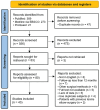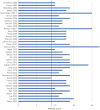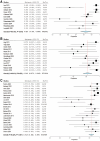Comparison of Clinical Outcomes After Different Surgical Approaches for Lateral Epicondylitis: A Systematic Review and Meta-analysis
- PMID: 38708009
- PMCID: PMC11067684
- DOI: 10.1177/23259671241230291
Comparison of Clinical Outcomes After Different Surgical Approaches for Lateral Epicondylitis: A Systematic Review and Meta-analysis
Abstract
Background: Lateral epicondylitis (LE) is one of the most common causes of lateral elbow pain. When nonoperative treatment fails, 1 of the 3 surgical approaches-open, percutaneous, or arthroscopic-is used. However, determining which approach has the superior clinical outcome remains controversial.
Purpose: To review the outcomes of different operative modalities for LE qualitatively and quantitatively.
Study design: Systematic review; Level of evidence, 4.
Methods: This review was performed and reported according to the PRISMA (Preferred Reporting Items for Systematic Reviews and Meta-Analyses) guidelines. Studies published in PubMed, Medline (via EBSCO), and ScienceDirect databases that treated LE with open, percutaneous, or arthroscopic approaches with at least 12 months of follow-up were included. Study quality was assessed using the Cochrane Risk of Bias 2 tool and the Methodological Index for Non-Randomized Studies score. The primary outcome was the success rate of each operative treatment approach-open, percutaneous, and arthroscopic.
Results: From an initial search result of 603 studies, 43 studies (n = 1941 elbows) were ultimately included. The arthroscopic approach had the highest success rate (91.9% [95% CI, 89.2%-94.7%]) compared with the percutaneous (91% [95% CI, 87.3%-94.6%]) and open (82.7% [95% CI, 75.6%-89.8%]) approaches for LE surgery with changes in the mean visual analog scale pain score of 5.54, 4.90, and 3.63, respectively. According to the Disabilities of the Arm, Shoulder and Hand score, the functional outcome improved in the arthroscopic group (from 54.11 to 15.47), the percutaneous group (from 44.90 to 10.47), and the open group (from 53.55 to 16.13). The overall improvement was also found in the Mayo Elbow Performance Score, the arthroscopic group (from 55.12 to 90.97), the percutaneous group (from 56.31 to 87.65), and the open group (from 64 to 93.37).
Conclusion: Arthroscopic surgery had the highest rate of success and the best improvement in functional outcomes among the 3 approaches of LE surgery.
Keywords: arthroscopic; lateral epicondylitis; surgical approach; tennis elbow.
© The Author(s) 2024.
Conflict of interest statement
The authors have declared that there are no conflicts of interest in the authorship and publication of this contribution. AOSSM checks author disclosures against the Open Payments Database (OPD). AOSSM has not conducted an independent investigation on the OPD and disclaims any liability or responsibility relating thereto.
Figures




Similar articles
-
Open, Arthroscopic, and Percutaneous Surgical Treatment of Lateral Epicondylitis: A Systematic Review.Hand (N Y). 2018 May;13(3):264-274. doi: 10.1177/1558944717701244. Epub 2017 Mar 24. Hand (N Y). 2018. PMID: 28720043 Free PMC article.
-
Arthroscopic and Open Surgery Show Comparable Efficacy in the Treatment of Lateral Epicondylitis: A Systematic Review.Arthroscopy. 2025 Jan 30:S0749-8063(25)00042-8. doi: 10.1016/j.arthro.2025.01.024. Online ahead of print. Arthroscopy. 2025. PMID: 39892435 Review.
-
Arthroscopic surgery versus open surgery for lateral epicondylitis in an active work population: a comparative study.J Shoulder Elbow Surg. 2022 May;31(5):984-990. doi: 10.1016/j.jse.2021.11.017. Epub 2021 Dec 30. J Shoulder Elbow Surg. 2022. PMID: 34973424
-
Clinical Outcomes of Open versus Arthroscopic Surgery for Lateral Epicondylitis, Evidence from a Systematic Review.Arch Bone Jt Surg. 2019 Mar;7(2):91-104. Arch Bone Jt Surg. 2019. PMID: 31211187 Free PMC article. Review.
-
[Benefit of Arthroscopy in Differential Diagnostics and Therapy of Lateral Epicondylitis].Acta Chir Orthop Traumatol Cech. 2023;90(1):41-46. Acta Chir Orthop Traumatol Cech. 2023. PMID: 36907582 Czech.
Cited by
-
Kinesio Taping, Wrist Splinting, and Epicondylitis Bandaging in Managing Lateral Epicondylitis: A Prospective Comparative Study.Med Sci Monit. 2025 May 4;31:e947642. doi: 10.12659/MSM.947642. Med Sci Monit. 2025. PMID: 40319348 Free PMC article. Clinical Trial.
-
Effects of Autologous Tenocyte Injection for Overuse and Degenerative Tendinopathies: A Systematic Review.J Funct Morphol Kinesiol. 2025 Mar 17;10(1):95. doi: 10.3390/jfmk10010095. J Funct Morphol Kinesiol. 2025. PMID: 40137347 Free PMC article. Review.
References
-
- Ang BFH, Mohan PC, Png MA, et al.. Ultrasonic percutaneous tenotomy for recalcitrant lateral elbow tendinopathy: clinical and sonographic results at 90 months. Am J Sports Med. 2021;49(7):1854-1860. - PubMed
-
- Arem Lim KS, Mile Ini EN, Amien Orestier DF, et al.. Methodological Index for Non-Randomized Studies (MINORS): development and validation of a new instrument. ANZ J Surg. 2003;73:712-716. - PubMed
-
- Baker CL, Baker CL. Long-term follow-up of arthroscopic treatment of lateral epicondylitis. Am J Sports Med. 2008;36(2):254-260. - PubMed
-
- Baker CL, Murphy KP, Gottlob CA, Curd DT. Arthroscopic classification and treatment of lateral epicondylitis: two-year clinical results. J Shoulder Elbow Surg. 2000;9(6):475-482. - PubMed
Publication types
LinkOut - more resources
Full Text Sources

